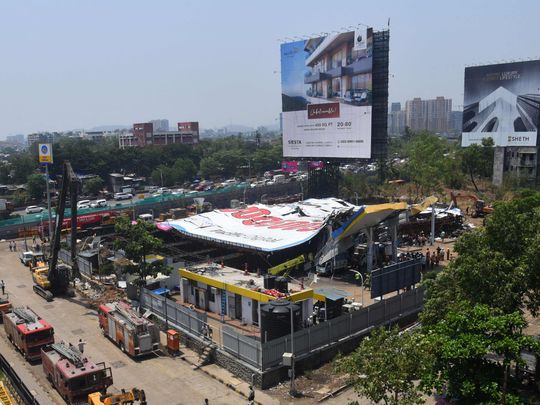
Right in the middle of election fever in India, a giant hoarding collapsed in Mumbai, one of India’s largest and certainly the richest metro. Fourteen innocent civilians died in the mishap and over 75 others sustained serious injuries. The massive billboard, 120 x 120 feet, was, as might be expected, illegal. The incident took place on Monday, May 13. Only this time, the damage was caused by the ferocious monsoon storms lashing the city, not by fervid or fiery campaign speeches or reckless electioneering.
How could this happen in the financial capital of India, with an overregulated municipality? The hoarding was erected by one of Mumbai’s largest billboard publicity handlers, ironically named M/s Ego Media. Its collapse, to say the least, ought to be a giant ego deflator not just to its criminal owner, Bhavesh Bhinde, but to all those who colluded with him to flout the existing rules which permit signboards no larger than 40 ft x 40 ft.
Bhinde, under the scanner in several prior offences, absconded after the disaster but has now been apprehended in Udaipur, Rajasthan, two states away. A school dropout from Mulund, he ran another company called Guju Ads, possibly signaling his family origins from Kutch, Gujarat. But Guju Ads was closed due to irregularities. No surprise. Bhinde has as many as 26 criminal cases, including rape, registered against him.
Finger-pointing
If so, how was this gigantic hoarding, with flimsy foundations, allowed to be put up in the first place? Apparently, it was on Railway land, in which case, as per a legal loophole, the permission of the Brihanmumbai Municipal Corporation or Municipal Corporation of Greater Mumbai (BMC), is not mandatory. Who, then, is responsible for this totally avoidable tragedy? There is much finger-pointing after the tragedy, but such illegal hoardings dot the highways of most major Indian cities.
Predictably, the politicians of various hues and affiliations that had gathered in Mumbai at the very same time failed to mention this terrible, man-made fatality. What about the bystanders who died? They had gathered under the shed of a nearby petrol pump to seek shelter from the pouring rain and the 60 km an hour winds during India's monsoon season.
The hoarding collapsed right on top of them. The arduous effort that ensued to pull out the survivors was hampered by the inability of the rescue teams to use electric metal cutters. There was already a gas leak in the petrol pump. The slightest spark might have resulted in an enormous conflagration with even more catastrophic consequences.
In a sad human-interest angle to this tragedy, an elderly couple who had driven from Madhya Pradesh to Mumbai, were also killed in their car. They had stopped at the gas station to fill up after a US visa interview. They were planning a trip to the United States to see their son. After frantically searching for his parents who had gone suddenly missing, the son, with the help of the police, tracked them because of their cell phones. They had died in the collapse of the hoarding.
This tragic event, occurring as it did during the peak of the election fervor, casts a dark shadow on the great festival of democracy. Does it not point to serious systemic rot that nobody thought it fit to address, let alone redress? The state government’s announcement of ex-gratia relief of 5 lakhs to the families of the deceased hardly touches the root cause, which is the endemic corruption and political interference afflicting urban infrastructure and governance.
Turning a blind eye
Each year, thousands die across the country in what should clearly be considered cases of culpable homicide caused by the neglect or corruption of civic and local authorities. Bridges and flyovers collapse, stampedes occur at local train stations, potholes and missing barriers cause thousands of accidents, even deaths, buildings collapse, factories catch fire and, yes, giant hoardings crush innocent citizens to death. But hardly anyone is held accountable.
Even if one or two culprits are brought to book, the system does not change.
The Ego Media billboard was not just a grotesque illegal erection but a lethal hazard that had seemingly been overlooked by civic authorities amidst the chaos of urban advertising, political propaganda, and endemic corruption.
A significant factor facilitating this is the unholy alliance between corrupt officials who turn a blind eye to infractions and their political patrons who benefit from the slush money that these hoardings provide. The resultant lack of accountability and enforcement against such illegal structures continues to endanger lives.
This calamity should conscientise us. It should compel us to question the integrity of our urban governance frameworks and demand a stricter adherence to safety standards and building codes. Municipal authorities must take immediate and uncompromising action against illegal constructions and ensure that such lethal negligence does not recur.
This incident must not just be mourned but also thoroughly investigated. We need to learn from our mistakes and drive the systemic transformations necessary to safeguard our cities and their denizens from similar fates in the future. The loss of 14 lives is not just a statistic; it's a poignant narrative of potential and promise unfulfilled due to collective failure.
Right during election time, such a tragedy should propel us towards a more responsible and responsive governance. Not just winning elections by hook or by crook, but truly serving the interests of the ordinary citizens of our country should be our top priority.
Else, just as this giant hoarding collapsed, our high and mighty elected leaders, who turn a blind eye to the suffering, even loss of lives, of ordinary women and men, will also come crashing down one day.







_resources1_16a45059ca3_small.jpg)

